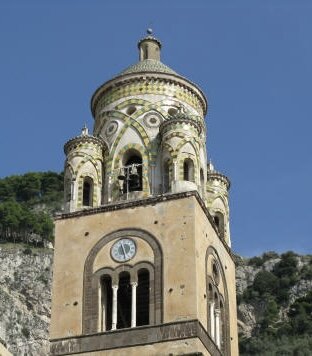The majestic beauty of the Amalfi Coast has always been irresistible. Greek sailors admired the dramatic landscape, even imagining parts of the coastline as home to mythic creatures. Later, wealthy Romans built seaside villas along the coast. In 839, Amalfi declared itself a Republic.

Amalfi remained a rich and powerful Republic until 1073 when it fell under Norman control. The power shift in the Mediterranean made Amalfi the target of attacks from the Pisans in the 1130’s. Despite this, Amalfi thrived during the 12th and 13th centuries. During this period, Amalfi sailors were among the first to introduce the compass for navigational purposes. Architecture flourished with a melange of styles. St. Andrew’s cathedral, originally two churches were merged into one Romanesque church. The facade was rebuilt in the 19th century in an Arab Moorish style. The Cloister of Paradise (1268) features slender interlaced columns surrounding a lush sculpted Mediterranean garden. The Campanile, built between 1180-1276, is a Romanesque-Moorish style bell tower. Its ornate towers are adorned with majolica. Majolica is a tin glazed earthen ware, which is fired a second time to produce vibrant, enduring colors.

By the 1230s Amalfi became one of the first locations in Europe to produce paper. Amalfi, and other towns along the coast, had an ideal location for paper making. Towns sitting at the base of travines, used the mountain water to power the paper mills. Amalfi’s paper was sold all over the Europe. Unlike parchment, which is made from animal hides, bambagina or rag paper, is made from shredded linen or cotton cloth. The shreds are bleached, mixed with water and ground into a pulp before being put on forms. The watermark, developed in Fabriano on the east coast of present day Italy, was applied while the pulp was drying and facilitated the identification of each mill’s product.

Paper making continued as an important local trade throughout the Middle Ages and Renaissance. Paper making in the bambagina style declined in importance as American wood pulp paper was cheaper and easier to produce. 1953, a flood destroyed 13 of the remaining 16 mills. I saw the ruins of the paper mills in Amalfi and Minori, but didn’t have time to visit the Museo della Carta (Paper Museum).

Amalfi’s period of prosperity changed drastically in the 14th century when the region was infected by the plague and a storm destroyed the main port, the sailing fleet and much of the town. Amalfi’s days as a major maritime Republic were over. The town came under the rule of the nearby Kingdom of Naples in the late 14th century.

Lacking military and trading influence, and without any land routes, the towns of Amalfi devolved back into a small, sleepy villages.

By the 19th century travellers from throughout Europe began to rediscover the history and beauty of the Naples area on the Grand Tour. Writers, poets, musicians and painters were enticed by the natural beauty of the area. Henry Longfellow arrived in 1869 and later wrote a poem entitled “Amalfi”. The town of Ravello and in particular the gardens of Villa Rufolo, inspired the operatic work, Parsifal, by Richard Wagner. John Steinbecks article in Harper’s Bazaar (1953), Positano, increased the allure of the small towns that dot the coastline.

Unfortunately, the surge in 20th century tourism has wreaked havoc on the infrastructure. The only road connecting the villages, SS 163, was designed and built in the early 1800’s. The road is incredibly scenic. However, traveling in a van or worse, a tour bus on a road which is never wider than 1 1/2 lanes, while hearing the warning beep beep of an oncoming vehicle just a few yards away on the other side of a blind curve, can be unnerving.
The scenery and the cliffside hikes make this region worth the effort, especially if you travel off season.
